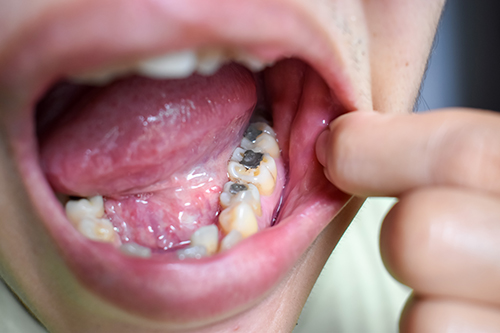Are your mercury dental fillings really gone?
If you ask the general public, “Are mercury fillings are still used?” Most likely you will get a resounding, “No, dentists stopped using them years ago!” Unfortunately, that is simply not true. In fact, a recently published paper using the largest US population study database, called the National Health and Nutrition Examination Survey (NHANES), has found that about half the US population over 15 years old, actually have mercury fillings and that the average number of fillings is 5 per person! What we don’t know is how many mercury fillings are in the mouths of those who are under 15 years of age. We do know, however, that mercury fillings are still being used, particularly in lower-income communities.

Silver amalgam fillings at right lower first molar and left lower second premolar
teeth in Asian, young man. Dental caries are also present showing poor oral hygiene.
Usually, the same people who think that dentists no longer use mercury, are the same people who say that they had their mercury dental fillings removed years ago…But, again that may not be true. A few decades ago, cosmetic dentistry came into fashion and people started to go to the dentist for the “perfect Hollywood Smile”, however, dentists back then and even now often will remove just a portion of the mercury filling material, and cover it with white composite resin. The end result is that mercury remains underneath the composite and is only visible through X-rays. A dentist who is well versed in looking at X-rays can see if mercury is still present. Hopefully, the dentist will also know how to safely correct the previous improperly done fillings.
Why is it so important for the patient to go back to redo the composite restorations and thoroughly remove all remaining mercury? While aesthetics may have been the driving force to get tooth, colored composites done in the first place, leaving behind mercury may cause health problems to the patient. First and foremost, there is usually decay around the old mercury filling, and that can create further damage to the tooth. Secondly, mercury continues to be released, even though it is covered with composite.
Removing mercury fillings, however, is a highly involved procedure and must be done properly to protect the patient and dental workers from additional mercury exposure. Andreoli et al. stated there are over 250 symptoms that are linked to mercury exposure, and that is why it is so difficult to diagnose – it travels through the body and can deposit anywhere. Mercury vapor from these fillings can cross the blood-brain barrier, and has also been linked to Alzheimer’s disease.
What can a patient do once they discover that mercury is still under their composite fillings?
The solution is to find a “certified” biological dentist that is highly skilled in safe mercury removal that also does biocompatibility testing prior to restoring the teeth again. This requires not only experience in doing a proper removal of all existing mercury but also having the best available technology to mitigate as much exposure to mercury as possible. The Huggins-Grube Protocol was specifically designed to provide a comprehensive treatment plan that includes a “Full Dental Revision” that restores the mouth as holistically as possible using biocompatible materials because there are no materials that are a “one size fits all” when it comes to dental restorations.
References/Sources
1). Estrich CG, Lipman RD, Araujo MWB. Dental amalgam restorations in nationally representative sample of US population aged ≥15 years: NHANES 2011–2016. Journal of Public Health Dentistry. (2021) 1-4.
2). Andreoli V, Sprovieri F, Genetic Aspects of Susceptibility to Mercury Toxicity: An Overview. Int. J. Environ. Res. Public Health. (2017) 14(1): 93
3). Siblerud R, Mutter J, Moore E, et al. A Hypothesis and Evidence That Mercury May be an Etiological Factor in Alzheimer’s Disease. Int. J. Environ. Res. Public Health (2019); 16(24), 5152.
4). https://hugginsappliedhealing.com/homepage/facts/the-huggins-grube-protocol/
5). https://biocomplabs.com
